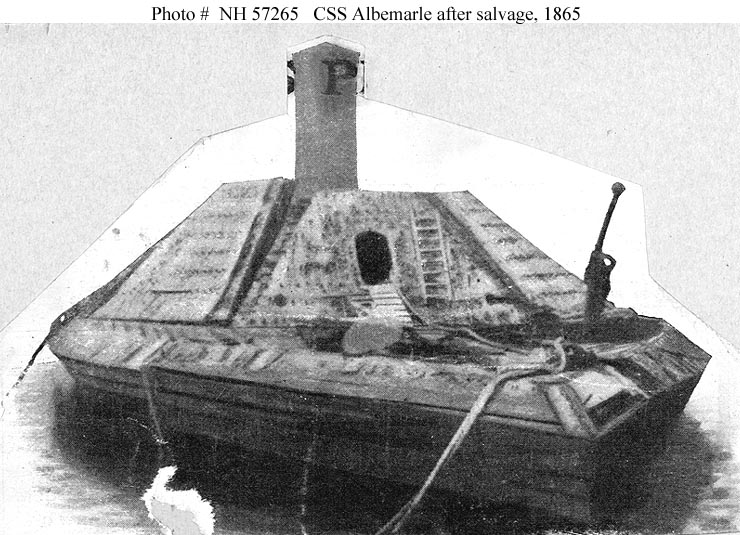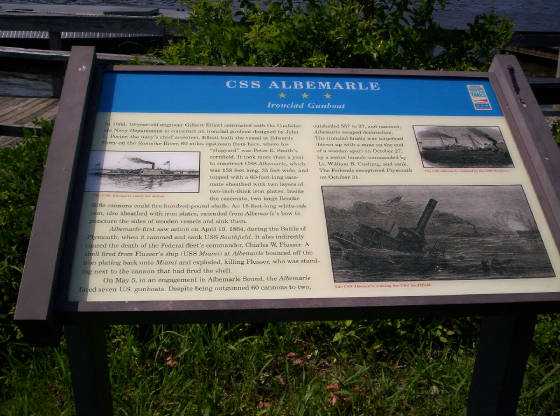|
CSS Albemarle : Anatomy of an Ironclad Gunboat
CSS Albemarle (1864-1864)
General characteristics
Displacement: 376 tons
Length: 158 feet
Beam: 35 feet
Draught:
9 feet
Speed: 4 knots
Complement: 150 officers and men
Armament: two eight-inch rifles

(Photo) CSS Albemarle (1864-1864). It is a halftone reproduction
of a photograph taken after the ship was salvaged, 1865. Donation of Rear Admiral Ammen C. Farenholt, 1938. U.S. Naval Historical Center Photograph.
| CSS Albemarle Ironclad Gunboat |

|
| CSS Albemarle Ironclad Gunboat |
CSS Albemarle, a relatively small ironclad ram, was built at Edwards
Ferry, North Carolina. Commissioned in April 1864 under the command of Commander J.W. Cooke, CSN, she almost immediately went
into action. On 19 April 1864, Albemarle attacked U.S. ships off Plymouth, N.C., sinking USS Southfield and driving away USS
Miami and two other gunboats. With their waterborne communications severed, the Union forces were forced to surrender Plymouth
to the Confederates.
Just over two weeks later, on 5 May, Albemarle, accompanied by the steamers Cotton Plant and Bombshell,
steamed out into the North Carolina Sounds and attacked another U.S. Navy force, consisting of the "Double-ender" gunboats
Sassacus, Wyalusing and Mattabesett, converted ferryboat Commodore Hull and small gunboat Ceres. Though Sassacus made a valiant
attempt to sink the Albemarle by ramming, she was badly damaged in return. The Confederate ironclad was but lightly damaged
in the engagement, which threatened the entire Union position on North Carolina's internal waters.
Desperate circumstances yield desperate responses, and on the night of 27-28 October 1864, Lieutenant William
B. Cushing, USN, took the torpedo boat Picket Boat Number One upriver to Plymouth and bravely attacked Albemarle at her berth,
sinking her with a spar torpedo. Following the Union recapture of the town, Albemarle was refloated. Taken to the Norfolk
Navy Yard in April 1865, she remained there until sold in October 1867.
Sources: United States Navy; United States Coast Guard
Recommended Reading: The Hunt for the Albemarle: Anatomy of a Gunboat War (Hardcover). Description: On
a muddy waterway, once called the River
of Death, James Cooke
and Charles Flusser met again after parting when the Civil War started. Once both navy lieutenants, they now were the opponents
in naval warfare. Confederate Navy Lieutenant James Cooke had as many years of active naval service as Charles Flusser had
years of living. Cooke was a devoted family man while Flusser was a bachelor with a mind for young Southern women, whiskey,
cigars, fast horses, and early promotion. Continued below...
The Confederate
ironclad Albemarle was the key to the river wars in North Carolina. Flusser's
search for this ship would determine the success or failure of the Union navy in securing the North Carolina coast and
rivers. James Cooke and the Confederates knew their only chance to break the blockade was with the new ironclad. The Hunt
for the Albemarle
is the dramatic story of these two men and their destiny. Both of these men shared one common characteristic. Each was willing
to die for the cause he believed was right.
Recommended
Reading: Iron Afloat: The Story of the Confederate Armorclads. Description: William N. Still's book is rightfully referred to as the standard of Confederate Naval history.
Accurate and objective accounts of the major and even minor engagements with Union forces are combined with extensive background
information. This edition has an enlarged section of historical drawings and sketches. Mr. Still explains the political background
that gave rise to the Confederate Ironclad program and his research is impeccable. An exhaustive literature listing rounds
out this excellent book. While strictly scientific, the inclusion of historical eyewitness accounts and the always fluent
style make this book a joy to read. This book is a great starting point.
Recommended
Reading: A History of Ironclads: The Power of Iron over Wood. Description: This
landmark book documents the dramatic history of Civil War ironclads and reveals how ironclad warships revolutionized naval
warfare. Author John V. Quarstein explores in depth the impact of ironclads during the Civil War and their colossal effect
on naval history. The Battle of Hampton Roads was one of history's greatest naval engagements. Over the course of two days
in March 1862, this Civil War conflict decided the fate of all the world's navies. It was the first battle between ironclad
warships, and the 25,000 sailors, soldiers and civilians who witnessed the battle vividly understood what history would soon
confirm: wars waged on the seas would never be the same. Continued below…
About the Author: John V. Quarstein is an award-winning author and historian. He is director
of the Virginia
War Museum in Newport News and chief historical advisor for The Mariners' Museum's new USS Monitor Center
(opened March 2007). Quarstein has authored eleven books and dozens of articles on American, military and Civil War history,
and has appeared in documentaries for PBS, BBC, The History Channel and Discovery Channel.
Recommended
Reading: Civil War Navies, 1855-1883 (The U.S.
Navy Warship Series) (Hardcover). Description: Civil War Warships, 1855-1883 is the second in the five-volume US Navy Warships
encyclopedia set. This valuable reference lists the ships of the U.S. Navy and Confederate Navy during the Civil War and the
years immediately following - a significant period in the evolution of warships, the use of steam propulsion, and the development
of ordnance. Civil War Warships provides a wealth and variety of material not found in other books on the subject and will
save the reader the effort needed to track down information in multiple sources. Continued below…
Each ship's
size and time and place of construction are listed along with particulars of naval service. The author provides historical
details that include actions fought, damage sustained, prizes taken, ships sunk, and dates in and out of commission as well
as information about when the ship left the Navy, names used in other services, and its ultimate fate. 140 photographs, including
one of the Confederate cruiser Alabama recently uncovered by the author further contribute to this
indispensable volume. This definitive record of Civil War ships updates the author's previous work and will find a lasting
place among naval reference works.
Recommended
Reading: The Rebel Raiders:
The Astonishing History of the Confederacy's Secret Navy (American Civil War). From Booklist: DeKay's modest monograph pulls together four separate stories from the naval
aspects of the American Civil War. All have been told before but never integrated as they are here. The first story is that
of James Bulloch, the Confederate agent who carefully and capably set out to have Confederate commerce raiders built in neutral
England. The second is that of the anti-American
attitudes of British politicians, far more extreme than conventional histories let on, and U.S. Ambassador Charles Francis
Adams' heroic fight against them. The third is a thoroughly readable narrative of the raider Alabama and her capable, quirky captain, Raphael Semmes. The final story is about the Alabama claims--suits for damages done to the U.S.
merchant marine by Confederate raiders, which became the first successful case of international arbitration. Sound and remarkably
free of fury, DeKay's commendable effort nicely expands coverage of the naval aspects of the Civil War.
Recommended
Reading: A History of the Confederate Navy
(Hardcover). From Publishers Weekly: One of the most prominent European scholars of the Civil War weighs in with a provocative
revisionist study of the Confederacy's naval policies. For 27 years, University of Genoa history professor Luraghi (The Rise
and Fall of the Plantation South) explored archival and monographic sources on both sides of the Atlantic to develop a convincing
argument that the deadliest maritime threat to the South was not, as commonly thought, the Union's blockade but the North's
amphibious and river operations. Confederate Navy Secretary Stephen Mallory, the author shows, thus focused on protecting
the Confederacy's inland waterways and controlling the harbors vital for military imports. Continued below…
As a result,
from Vicksburg
to Savannah to Richmond, major
Confederate ports ultimately were captured from the land and not from the sea, despite the North's overwhelming naval strength.
Luraghi highlights the South's ingenuity in inventing and employing new technologies: the ironclad, the submarine, the torpedo.
He establishes, however, that these innovations were the brainchildren of only a few men, whose work, although brilliant,
couldn't match the resources and might of a major industrial power like the Union. Nor did
the Confederate Navy, weakened through Mallory's administrative inefficiency, compensate with an effective command system.
Enhanced by a translation that retains the verve of the original, Luraghi's study is a notable addition to Civil War maritime
history. Includes numerous photos.
Recommended Reading: The Confederate Navy in Europe. Description: The Confederate
Navy in Europe is an account of the Confederate officers and officials who went on missions to Britain
and France to buy ships for the CS Navy,
and to support CSN operations on the high seas, such as commerce raiding. Spencer tells the story of how some officers rose
to the occasion (some did not) and did a lot with limited resources. The majority of the ships ordered never reached America. Shipbuilding takes time, and as the war dragged on
the European powers were persuaded by Confederate battlefield misfortunes and US
diplomatic pressure that it was most expedient to deny the sales of such innovative designs as ocean-going ironclads. Like
other out-manned and out-gunned powers, the CSA did have to resort to ingenuity and innovation.
Recommended
Reading: Civil War Ironclads: The U.S. Navy and Industrial Mobilization (Johns Hopkins
Studies in the History of Technology). Description: "In this impressively researched and broadly conceived study, William
Roberts offers the first comprehensive study of one of the most ambitious programs in the history of naval shipbuilding, the
Union's ironclad program during the Civil War. Perhaps more importantly, Roberts also provides
an invaluable framework for understanding and analyzing military-industrial relations, an insightful commentary on the military
acquisition process, and a cautionary tale on the perils of the pursuit of perfection and personal recognition." - Robert
Angevine, Journal of Military History "Roberts's study, illuminating on many fronts, is a welcome addition to our understanding
of the Union's industrial mobilization during the Civil War and its inadvertent effects on the postwar U.S. Navy." - William
M. McBride, Technology and Culture"
|

